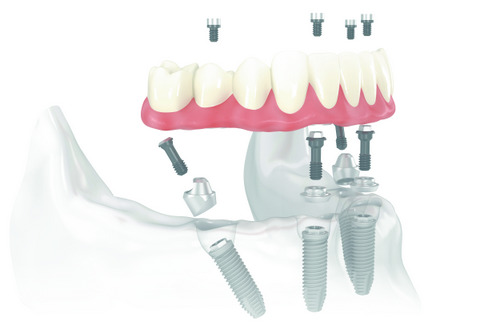 For some edentulous patients (people lacking most or all of their teeth), it’s more difficult than normal to perform an implant-supported prosthesis procedure without more complex and therefore often costlier methods. One preferable solution in such cases is the All-on-4 treatment concept. The term “All-on-4” means that “all” of one’s teeth are supported “on four” dental implants.
For some edentulous patients (people lacking most or all of their teeth), it’s more difficult than normal to perform an implant-supported prosthesis procedure without more complex and therefore often costlier methods. One preferable solution in such cases is the All-on-4 treatment concept. The term “All-on-4” means that “all” of one’s teeth are supported “on four” dental implants.This surgery is common for full-arc treatment utilizing tilted implants, granting a reliable means of fully rehabilitating those living with teeth which are severely worn, damaged, diseased, decayed, or otherwise irreparable. It was in 1998 that Dr. Paulo Malo performed the first successful treatment with straight and angled multi-unit abutments, a method since used to help hundreds-thousands of patients.
We'd love to help answer all your many questions about the All-on-4 Treatment Concept. Please call Lakewood Dental Arts today at (562) 384-1091!
What are All-On-4 implants?
An implant is a small (usually titanium) screw inserted into your jawbone in the space left from a missing tooth. Once in place, a false tooth or crown is positioned on top of this screw. An All-On-4 implant basically takes the same principle, but with four implants together.
What are the characteristics of All-On-4 treatment?
| • | Full-arch rehabilitation with only four implants, two being straight anterior and two being tilted up to 45 degrees further in the back. |
| • | A fixed provisional bridge provides immediate restored dental function, for patients who meet the criteria for immediate placement of implants. |
| • | All-on-4 is a graftless procedure, avoiding bone grafting through titling the implants in the back with all available bone. |
How are All-On-4 implants inserted?
Instead of replacing every missing tooth with an individual implant, we take a less complicated route by placing two in the upper jaw and two in the lower jaw as your teeth’s primary anchors. Our doctors will then connect a denture in the same locations, linking them together in a supportive structure.
What factors should be considered for All-On-4 treatment?
While All-on-4 treatment is a popular request among visitors, it’s important for professionals meeting with and examining a patient to first confirm whether he/she actually needs it. Furthermore, not every patient meets the criteria required to handle it without risk of complications. Areas to evaluate include:
| • | Speech issues. |
| • | Difficulty in adapting to the thickness of a bridge. |
| • | Proprioception - Perception or awareness of the body’s position and movement. |
| • | Parafunction - Habitually using a part of the body (in the patient’s case, a part of the mouth) in a way outside its normal purpose, which may play into their eligibility for the procedure. |
| • | High caries index - Patients at higher risk for a variety of reasons (physical or mental health, disease, etc). |
What are the advantages of All-On-4 treatment?
| • | Immediate improvement to quality of life. |
| • | A fixed full-arch prosthesis on the day of the procedure quickly improves patient satisfaction in regards to function, appearances, awareness, speech, and self-confidence. |
| • | Shorter treatment time. |
| • | Consistently high success rate. |
| • | The implants are well spaced and easier to clean. |
| • | If necessary, a final restoration can be fixed or removed. |
| • | Angled posterior implants do not interfere with other anatomical structures in the mouth or face. These also allow longer implants to be anchored within better quality bone. |
| • | As said, tilting the posterior implants makes time-consuming bone grafting procedures unnecessary. |
| • | All-on-4 treatment reduces the posterior cantilever (tooth bridge). |
| • | Cost-effective, due to lesser number of implants and avoidance of bone grafting in most cases. |
What are the limits of All-On-4 treatment?
| • | Patients with poor general health or dental hygiene are not eligible for the procedure. |
| • | Patients lacking enough quality bone for four implants are not eligible. |
| • | The implants only grant effective stability for immediate function and activity. |
What are the disadvantages of All-On-4 treatment?
| • | It is not always possible to surgically place the implant free-hand, as the implementation is completely prosthetically driven. |
| • | The length of the cantilever used in the prosthesis cannot exceed its limit. |
| • | All-on-4 treatment is a delicate procedure requiring sensitive technique and extensive surgical preparations, including a surgical splint and CAD/CAM (computer-aided design and computer-aided manufacturing). |
Remember, if you or a loved one are considering All-On-4 treatment and want to schedule a consultation with our doctors, call us at (562) 384-1091.
